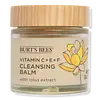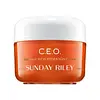What's inside
What's inside
 Key Ingredients
Key Ingredients

 Benefits
Benefits

 Concerns
Concerns

 Ingredients Side-by-side
Ingredients Side-by-side

Caprylic/Capric Triglyceride
MaskingHelianthus Annuus Seed Oil
EmollientCocos Nucifera Oil
MaskingPolyglyceryl-3 Diisostearate
EmulsifyingSorbitan Sesquioleate
EmulsifyingHeptyl Undecylenate
EmollientPolyglyceryl-10 Laurate
Skin ConditioningPolyglyceryl-3 Cocoate
EmulsifyingHelianthus Annuus Seed Wax
Skin ConditioningGlycerin
HumectantLauryl Laurate
Skin ConditioningJojoba Esters
EmollientBehenyl Behenate
EmollientWater
Skin ConditioningGlyceryl Stearate Se
EmulsifyingPolyhydroxystearic Acid
EmulsifyingTetrahexyldecyl Ascorbate
AntioxidantTocopherol
AntioxidantCorylus Avellana Seed Oil
EmollientEuphorbia Cerifera Wax
Acacia Decurrens Flower Wax
EmollientNymphaea Caerulea Flower Extract
Skin ConditioningOrmenis Multicaulis Extract
MaskingSucrose Laurate
EmollientPolyglycerin-3
HumectantLinoleic Acid
CleansingLinolenic Acid
CleansingParfum
MaskingBenzyl Salicylate
PerfumingGeraniol
PerfumingLimonene
PerfumingCaprylic/Capric Triglyceride, Helianthus Annuus Seed Oil, Cocos Nucifera Oil, Polyglyceryl-3 Diisostearate, Sorbitan Sesquioleate, Heptyl Undecylenate, Polyglyceryl-10 Laurate, Polyglyceryl-3 Cocoate, Helianthus Annuus Seed Wax, Glycerin, Lauryl Laurate, Jojoba Esters, Behenyl Behenate, Water, Glyceryl Stearate Se, Polyhydroxystearic Acid, Tetrahexyldecyl Ascorbate, Tocopherol, Corylus Avellana Seed Oil, Euphorbia Cerifera Wax, Acacia Decurrens Flower Wax, Nymphaea Caerulea Flower Extract, Ormenis Multicaulis Extract, Sucrose Laurate, Polyglycerin-3, Linoleic Acid, Linolenic Acid, Parfum, Benzyl Salicylate, Geraniol, Limonene
Water
Skin ConditioningSqualane
EmollientDicaprylyl Carbonate
EmollientTetrahexyldecyl Ascorbate
AntioxidantC10-18 Triglycerides
EmollientPEG-8 Beeswax
EmulsifyingPolyglyceryl-6 Distearate
EmulsifyingTapioca Starch
Hydrogenated Vegetable Oil
EmollientPrunus Amygdalus Dulcis Oil
Skin ConditioningCitric Acid
BufferingPPG-12/Smdi Copolymer
EmollientGlycerin
HumectantCitrus Tangerina Peel Oil
MaskingSodium Acrylates Copolymer
Bisabolol
MaskingJojoba Esters
EmollientTocopherol
AntioxidantCaprylic/Capric Triglyceride
MaskingLimonene
PerfumingPhenoxyethanol
PreservativeLecithin
EmollientNylon-12
Rosa Centifolia Flower Wax
Skin ConditioningRosa Damascena Flower Wax
MaskingSodium Phytate
Cetyl Alcohol
EmollientPolyglyceryl-3 Beeswax
EmulsifyingButylene Glycol
HumectantCaprylyl Glycol
EmollientAlcohol Denat.
AntimicrobialChlorphenesin
AntimicrobialCitrus Australasica Fruit Extract
AntioxidantPolymethylsilsesquioxane
Terminalia Ferdinandiana Fruit Extract
AntioxidantButyrospermum Parkii Butter Extract
Skin ConditioningCamellia Sinensis Leaf Extract
AntimicrobialCitrus Junos Fruit Extract
Skin ConditioningCurcuma Longa Root Extract
MaskingEuterpe Oleracea Fruit Extract
Lippia Citriodora Flower Extract
PerfumingOenothera Biennis Seed Extract
Skin ConditioningRosa Canina Fruit Extract
AstringentAlteromonas Ferment Extract
Skin ConditioningBenzyl Alcohol
PerfumingSodium Hyaluronate
HumectantLinalool
PerfumingDehydroacetic Acid
PreservativeWater, Squalane, Dicaprylyl Carbonate, Tetrahexyldecyl Ascorbate, C10-18 Triglycerides, PEG-8 Beeswax, Polyglyceryl-6 Distearate, Tapioca Starch, Hydrogenated Vegetable Oil, Prunus Amygdalus Dulcis Oil, Citric Acid, PPG-12/Smdi Copolymer, Glycerin, Citrus Tangerina Peel Oil, Sodium Acrylates Copolymer, Bisabolol, Jojoba Esters, Tocopherol, Caprylic/Capric Triglyceride, Limonene, Phenoxyethanol, Lecithin, Nylon-12, Rosa Centifolia Flower Wax, Rosa Damascena Flower Wax, Sodium Phytate, Cetyl Alcohol, Polyglyceryl-3 Beeswax, Butylene Glycol, Caprylyl Glycol, Alcohol Denat., Chlorphenesin, Citrus Australasica Fruit Extract, Polymethylsilsesquioxane, Terminalia Ferdinandiana Fruit Extract, Butyrospermum Parkii Butter Extract, Camellia Sinensis Leaf Extract, Citrus Junos Fruit Extract, Curcuma Longa Root Extract, Euterpe Oleracea Fruit Extract, Lippia Citriodora Flower Extract, Oenothera Biennis Seed Extract, Rosa Canina Fruit Extract, Alteromonas Ferment Extract, Benzyl Alcohol, Sodium Hyaluronate, Linalool, Dehydroacetic Acid
 Reviews
Reviews

Ingredients Explained
These ingredients are found in both products.
Ingredients higher up in an ingredient list are typically present in a larger amount.
This ingredient is an emollient, solvent, and texture enhancer. It is considered a skin-softener by helping the skin prevent moisture loss.
It helps thicken a product's formula and makes it easier to spread by dissolving clumping compounds.
Caprylic Triglyceride is made by combining glycerin with coconut oil, forming a clear liquid.
While there is an assumption Caprylic Triglyceride can clog pores due to it being derived from coconut oil, there is no research supporting this.
Learn more about Caprylic/Capric TriglycerideGlycerin is already naturally found in your skin. It helps moisturize and protect your skin.
A study from 2016 found glycerin to be more effective as a humectant than AHAs and hyaluronic acid.
As a humectant, it helps the skin stay hydrated by pulling moisture to your skin. The low molecular weight of glycerin allows it to pull moisture into the deeper layers of your skin.
Hydrated skin improves your skin barrier; Your skin barrier helps protect against irritants and bacteria.
Glycerin has also been found to have antimicrobial and antiviral properties. Due to these properties, glycerin is often used in wound and burn treatments.
In cosmetics, glycerin is usually derived from plants such as soybean or palm. However, it can also be sourced from animals, such as tallow or animal fat.
This ingredient is organic, colorless, odorless, and non-toxic.
Glycerin is the name for this ingredient in American English. British English uses Glycerol/Glycerine.
Learn more about GlycerinJojoba Esters is a wax created from Jojoba oil. It is an emollient and film-forming ingredient. In bead form, it is an exfoliator.
This ingredient has high oxidative stability, meaning it doesn't break down when exposed to oxygen.
Its similarity to our skin's natural oils makes it a great emollient. Emollients help soften and soothe our skin by creating a barrier on top. This barrier helps trap moisture in, keeping skin hydrated.
It is created using either the hydrogenation or transesterification processes on jojoba oil.
Learn more about Jojoba EstersLimonene is a fragrance that adds scent and taste to a formulation.
It's found in the peel oil of citrus fruits and other plants such as lavender and eucalyptus. The scent of limonene is generally described as "sweet citrus".
Limonene acts as an antioxidant, meaning it helps neutralize free radicals.
When exposed to air, oxidized limonene may sensitize the skin. Because of this, limonene is often avoided by people with sensitive skin.
The term 'fragrance' is not regulated in many countries. In many cases, it is up to the brand to define this term. For instance, many brands choose to label themselves as "fragrance-free" because they are not using synthetic fragrances. However, their products may still contain ingredients such as essential oils that are considered a fragrance.
Learn more about LimoneneTetrahexyldecyl Ascorbate (THD) is a stable and oil-soluble form of Vitamin C.
THD is special in that it has the ability to travel deeper into skin than traditional ascorbic acid while maintaining the same skin benefits (double win!).
Because it’s oil-soluble, THD dives deep into your skin’s fatty layers (think ceramides and cholesterol) to fight off the kind of free radicals that mess with your skin barrier. This makes it a great pair with water-based vitamin C (ascorbic acid) that mainly works on the surface.
Even at just 0.1%, THD is already showing great antioxidant activity. When used up to 2%, it helps keep your skin happy and calm, especially when it’s stressed from pollution or sun.
Want to fade dark spots or tackle hyperpigmentation? You’ll want 5% or more. Pairing it with brightening buddies like niacinamide or licorice root gives even better results. One study even used 30% THD with other brighteners and saw real results on stubborn discoloration, even in melasma-prone skin.
A note on THD: It’s has a slightly silky, oily texture and usually shows up colorless or pale yellow (though the exact shade can vary by supplier).
While you can sneak it into water-based formulas, it really shines when paired with silicones or oils, which help your skin soak it up better.
THD is pretty stable, but it’s still vulnerable to degradation like ascorbic acid. Too much light or heat (above 113°F / 45°C) can break it down over time. Go for dark and opaque packaging that keeps it safe and shady!
Read more about other types of Vitamin C:
Learn more about Tetrahexyldecyl AscorbateTocopherol (also known as Vitamin E) is a common antioxidant used to help protect the skin from free-radicals and strengthen the skin barrier. It's also fat soluble - this means our skin is great at absorbing it.
Vitamin E also helps keep your natural skin lipids healthy. Your lipid skin barrier naturally consists of lipids, ceramides, and fatty acids. Vitamin E offers extra protection for your skin’s lipid barrier, keeping your skin healthy and nourished.
Another benefit is a bit of UV protection. Vitamin E helps reduce the damage caused by UVB rays. (It should not replace your sunscreen). Combining it with Vitamin C can decrease sunburned cells and hyperpigmentation after UV exposure.
You might have noticed Vitamin E + C often paired together. This is because it is great at stabilizing Vitamin C. Using the two together helps increase the effectiveness of both ingredients.
There are often claims that Vitamin E can reduce/prevent scarring, but these claims haven't been confirmed by scientific research.
Learn more about TocopherolWater. It's the most common cosmetic ingredient of all. You'll usually see it at the top of ingredient lists, meaning that it makes up the largest part of the product.
So why is it so popular? Water most often acts as a solvent - this means that it helps dissolve other ingredients into the formulation.
You'll also recognize water as that liquid we all need to stay alive. If you see this, drink a glass of water. Stay hydrated!
Learn more about Water